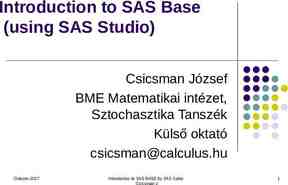Studies of Conformity Sherif & Asch
22 Slides405.31 KB
Studies of Conformity Sherif & Asch
How many sweets are in the jar? You will see a picture of a jar of sweets. You will need to decide how many sweets you think are in the jar and write your answer down privately. You must not share your answer with anyone else
How many sweets are in the jar? You will now be put into groups of three. The sweet jar will be shown for a second time and this time you can discuss your estimate with the other people in your group. You must then give a group estimate
How many sweets are in the jar? This is your final opportunity to estimate how many sweets are in the jar. This time do it individually. Make a final guess and write it down
Did you conform? Were there large differences between the individual estimates of group members in trial 1? Was the figure in the group estimate condition (trial 2) an averaging out of the individual responses? Put your hand up if your final estimate was closer to the group norm established in the group condition, than it was to the first estimate that you gave Did anyone stick with their first estimate, regardless of the what the group decided? Did people conform due to informational or normative social influence? Why? On mini whiteboards, explain how the results of this experiment demonstrate internalisation What we have done in the class is very similar to a study carried out by Sherif. On the next slide you are going to read the details of his study. Try to remember as much as you can because you will be asked to recall the details in the next exercise
Read the details of Sherif’s study of conformity: Sherif (1935) carried out a laboratory experiment using a repeated measures design. He used the autokinetic effect to demonstrate conformity. The autokinetic effect is an optical illusion that is experienced when a person, placed in a completely dark room, perceives a stationary light to be moving. Participants were first asked to judge, individually, over several trials, how far the light appeared to move (condition 1). The participants were then put into groups of three, and asked to estimate again, announcing their estimates aloud (condition 2). They were then asked to go back to estimating individually (condition 3). Sherif found that in condition 1, each individual’s estimates were relatively stable, but there was considerable variation between participants (between 2 and 12 inches – 5cm and 30 cm). In condition 2, their judgements converged towards a group norm. In other words their group answer tended to be an average of the individual estimates. In condition 3, the individual participants tended to maintain the group norm This study shows that when faced with an ambiguous situation (when the right answer is not clear), the participants looked to others for help and guidance. This can be explained by informational social influence, as the participants will changed their thoughts and actions because they were uncertain what estimate to give in this ambiguous situation. The finding that the individuals continued to use the group estimate when they were away from the group demonstrates that they had internalised the estimate of the distance.
Sherif’s study of conformity Now attempt to summarise the main details of the study in 6 bullet points, making sure that you include the most important information Did you get these points? Participants were first asked to judge, individually, over several trials, how far the light appeared to move (the autokinetic effect) . The participants were then put into groups of three, and asked to estimate again, announcing their estimates aloud. They were then asked to go back to estimating individually Sherif found that in condition 1, each individual’s estimates were relatively stable, but there were wide individual differences In condition 2, their judgements converged towards a group norm and in condition 3, the individual participants tended to maintain the group norm. This can be explained by informational social influence, as the participants will have changed their thoughts and actions because they were uncertain what estimate to give in this ambiguous situation The finding that the individuals continued to use the group estimate when they were away from the group demonstrates that they had internalised the estimate of the distance.
Evaluation of Sherif’s study Applications These findings can be used to show that working in groups can be useful (or problematic) if there is no exact answer Who would find this useful? Educators?
Evaluation of Sherif’s study In a similar research study, Jenness asked Ps to guess how many beans were in a glass jar, the findings were consistent when discussed in a group, but differed considerably when asked individually What does this suggest about Sherif’s research?
Evaluation of Sherif’s study The procedure is well controlled Why is this an advantage in this study? (Be specific, not generic)
The task used by Sherif is far from an everyday task that represents everyday life. It is hard to imagine that people would often discuss how far a point of light appears to be moving in a darkened room, and so the study lacks ecological validity How might the artificiality of the study affect the results? Be specific
Asch’s study of conformity Go up to the big whiteboards, in your groups, and write as much as you can remember about Asch’s study of conformity. You should include: The aim of the study A diagram to show how the study was carried out What the task involved The results The conclusion https://www.youtube.com/watch?v NyDDyT1lDh A
Asch’s study of conformity The general rate of conformity across trials was 32% What does this figure mean? We are going to look at a fictitious replication of Asch’s procedure which will help us understand the relevance of the results Explanation of Asch’s results
What do Asch’s results suggest about conformity? Answer these questions on mini whiteboards: 1. Is Asch’s study a demonstration of informational or normative social influence? (be prepared to give a reason for your answer) 2. Which type of conformity is demonstrated in the Asch procedure (be prepared to give a reason for your answer)
Your first 16 mark essay We’re going to introduce you to writing a 16 mark essay and instruct you in how to structure one. 16 marks is the most marks that will be allocated to a single question. A question worth 16 marks will always be an essay question. You may get as many as 4 16 mark essays in a paper (each paper is out of 96 marks) They come in different formats, but just for first one. We’ll start with a very straight forward question “Outline and evaluate explanations of conformity” 16 marks
The basic structure of essays In any essay, one third of the marks is available for AO1 information This means that in a 16 mark essay, 6 marks are available for this AO1 refers to outlines and descriptions of concepts, theories, or studies On MWBs, what information that we have looked at in this topic so far would count as AO1 information? Explanations of conformity Types of conformity Sherif’s study of conformity Asch’s study of conformity
The basic structure of essays What information are we going to use for our outline (AO1)? Informational social influence Normative social influence Now see if you can complete a bullet point plan for the AO1 part of the essay. Think about: What is informational social influence? When is it likely to occur? What type of conformity does it usually lead to? Give an example Now do the same for normative social influence
The basic structure of essays In any essay, two thirds of the marks are available for AO2 and or AO3 information This means that in a 16 mark essay, 10 marks are available for this AO2 refers to application. This means that you are given a novel scenario and you have to apply your knowledge directly to that scenario (AO2 content is not required in this essay) AO3 refers to evaluation and analysis. This is where you critically assess the strengths and weaknesses of a theory, or concept, or study On MWBs, what information that we have looked at in this topic so far would count as AO3 information? Evaluation of Sherif’s study of conformity
AO3: Evaluating theories and studies There are many different ways of evaluating theories and studies in Psychology Turn to p.14 in the student handbook and on MWBs, using the information outline three ways we might evaluate a theory. Make sure you can describe them in your own words Now, using the information on p.15, list three ways in which evaluating a study is different from evaluating a theory Assessing the validity and reliability of the
AO3: Evaluating theories and studies To be able to get our 10 marks for evaluation we should aim to provide three PEEL evaluation points. PEEL refers to how we structure our evaluation: Point Sherif’s study using the autokinetic effect gives support for the existence of informational social influence Explain Sherif found that when participants were asked to judge how far a spot of light had moved in a dark room, when answering individually, estimates were relatively stable, but there was considerable variation between participants (between 2 and 12 inches – 5cm and 30 cm). However, when they were put into groups of three their judgements converged towards a group norm. Elaborate Sherif suggests this is because the task is difficult and therefore the group members are more likely to look to others to guide them to the right answer Link back therefore supporting the view that informational influence leads to conformity For example.
Now let’s try to complete the plan. What other study might we use as supporting evidence in our essay? Have a go at writing a bullet point PEEL evaluation for Asch’s study We are going to consider whether there any useful applications of the research What does that mean? Can you think of an application of the research Write a bullet point PEEL point for useful applications Your homework is to write an essay at home using the plan you have made You must bring the essay to class this time next week, when you will be self assessing it using a model answer
Evaluation of Asch’s study Now we’ve had some practice at writing PEEL points, see if you can complete the worksheet on evaluating Asch’s study of conformity



























